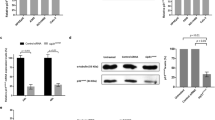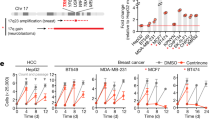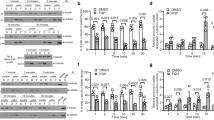Abstract
Paclitaxel (PTX) and other microtubule inhibitors cause mitotic arrest. However, low concentrations of PTX (low PTX) paradoxically cause G1 arrest (without mitotic arrest). Here, we demonstrated that unexpectedly, low PTX did not cause G1 arrest in the first cell cycle and did not prevent cells from passing through S phase and entering mitosis. Mitosis was prolonged but cells still divided, producing either two or three cells (tripolar mitosis), thus explaining a sub G1 peak caused by low PTX. Importantly, sub G1 cells were viable and non-apoptotic. Some cells fused back and then progressed to mitosis, frequently producing three cells again before becoming arrested in the next cell-cycle interphase. Thus, low PTX caused postmitotic arrest in second and even the third cell cycles. By increasing concentration of PTX, tripolar mitosis was transformed to mitotic slippage, thus eliminating a sub G1 peak. Time-lapse microscopy revealed that prolonged mitosis ensured a p53-dependent postmitotic arrest. We conclude that PTX directly affects cells only in mitosis and the duration of mitosis determines cell fate, including p53-dependent G1-like arrest.
This is a preview of subscription content, access via your institution
Access options
Subscribe to this journal
Receive 50 print issues and online access
$259.00 per year
only $5.18 per issue
Buy this article
- Purchase on Springer Link
- Instant access to full article PDF
Prices may be subject to local taxes which are calculated during checkout








Similar content being viewed by others
References
Abal M, Andreu JM, Barasoain I . (2003). Taxanes: microtubule and centrosome targets, and cell cycle dependent mechanisms of action. Curr Cancer Drug Targets 3: 193–203.
An WG, Chuman Y, Fojo T, Blagosklonny MV . (1998). Inhibitors of transcription, proteasome inhibitors, and DNA-damaging drugs differentially affect feedback of p53 degradation. Exp Cell Res 244: 54–60.
Andreassen PR, Lohez OD, Lacroix FB, Margolis RL . (2001). Tetraploid state induces p53-dependent arrest of nontransformed mammalian cells in G1. Mol Biol Cell 12: 1315–1328.
Blagosklonny MV . (2006). Prolonged mitosis versus tetraploid checkpoint: how p53 measures the duration of mitosis. Cell Cycle 5: 971–975.
Blagosklonny MV . (2007). Mitotic arrest and cell fate: why and how mitotic inhibition of transcription drives mutually exclusive events. Cell Cycle 6: 70–74.
Blagosklonny MV, Darzynkiewicz Z, Halicka HD, Pozarowski P, Demidenko ZN, Barry JJ et al. (2004). Paclitaxel Induces Primary and Postmitotic G(1) Arrest in Human Arterial Smooth Muscle Cells. Cell Cycle 3: 1050–1056.
Blagosklonny MV, Demidenko ZN, Fojo T . (2002). Inhibition of transcription results in accumulation of Wt p53 followed by delayed outburst of p53-inducible proteins: p53 as a sensor of transcriptional integrity. Cell Cycle 1: 67–74.
Blagosklonny MV, Fojo T . (1999). Molecular effects of paclitaxel: myths and reality. Int J Cancer 83: 151–156.
Broude EV, Demidenko ZN, Vivo C, Swift ME, Davis BM et al. (2007). P21 (CDKN1A) is a negative regulator of p53 stability. Cell Cycle 6: 1468–1471.
Cross SM, Sanchez CA, Morgan CA, Schimke MK, Ramel S, Idzerda RL et al. (1995). A p53-dependent mouse spindle checkpoint. Science 267: 1353–1356.
Demidenko ZN, Blagosklonny MV . (2004). Flavopiridol induces p53 via initial inhibition of Mdm2 and p21 and, independently of p53, sensitizes apoptosis-reluctant cells to tumor necrosis factor. Cancer Res 64: 3653–3660.
Di Leonardo A, Khan SH, Linke SP, Greco V, Seidita G, Wahl GM . (1997). DNA rereplication in the presence of mitotic spindle inhibitors in human and mouse fibroblasts lacking either p53 or pRb function. Cancer Res 57: 1013–1019.
Fukasawa K, Vande Woude GF . (1997). Synergy between the Mos/mitogen-activated protein kinase pathway and loss of p53 function in transformation and chromosome instability. Mol Cell Biol 17: 506–518.
Giannakakou P, Nakano M, Nicolaou KC, O'Brate A, Yu J, Blagosklonny MV et al. (2002). Enhanced microtubule-dependent trafficking and p53 nuclear accumulation by suppression of microtubule dynamics. Proc Natl Acad Sci USA 99: 10855–10860.
Giannakakou P, Robey R, Fojo T, Blagosklonny MV . (2001). Low concentrations of paclitaxel induce cell type-dependent p53, p21 and G1/G2 cell cycle arrest instead of mitotic arrest: molecular determinants of paclitaxel-induced cytotoxicity. Oncogene 20: 3806–3813.
Giannakakou P, Sackett DL, Ward Y, Webster KR, Blagosklonny MV, Fojo T . (2000). p53 is associated with cellular microtubules and is transported to the nucleus by dynein. Nat Cell Biol 2: 709–717.
Gottesfeld JM, Forbes DJ . (1997). Mitotic repression of the transcriptional machinery. Trends Biochem Sci 22: 197–202.
Horwitz SB . (1992). Mechanism of action of taxol. Trends Pharmacol Sci 13: 134–136.
Jordan MA, Wendell K, Gardiner S, Derry WB, Copp H, Wilson L . (1996). Mitotic block induced in HeLa cells by low concentrations of paclitaxel (taxol) results in abnormal mitotic exit and apoptotic cell death. Cancer Res 56: 816–825.
Jordan MA, Wilson L . (2004). Microtubules as a target for anticancer drugs. Nat Rev Cancer 4: 253–265.
Kessous A, Colombies P, Pris J, Clement D . (1980). Near haploid cell line in lymphoid blast crisis of Ph1-positive chronic myeloid leukemia. Cancer Res 40: 1354–1359.
Khan SH, Wahl GM . (1998). p53 and pRb prevent rereplication in response to microtubule inhibitors by mediating a reversible G1 arrest. Cancer Res 58: 396–401.
Lanni JS, Jacks T . (1998). Characterization of the p53-dependent postmitotic checkpoint following spindle disruption. Mol Cell Biol 18: 1055–1064.
Mantel C, Guo Y, Lee MR, Han M-K, Rhorabough S, Kim K-S et al. (2008). Cells enter a unique intermediate 4N stage, not 4N-G1, after aborted mitosis. Cell Cycle 7: 484–492.
Martinez-Balbas MA, Dey A, Rabindran SK, Ozato K, Wu C . (1995). Displacement of sequence-specific transcription factors from mitotic chromatin. Cell 8: 29–38.
Prescott DM . (1964). Cellular sites of RNA synthesis. Prog Nucl Acid Res Mol Biol 3: 33–45.
Rieder CL, Maiato H . (2004). Stuck in division or passing through: what happens when cells cannot satisfy the spindle assembly checkpoint. Dev Cell 7: 637–651.
Rowinsky EK, Donehower RC . (1995). Paclitaxel (Taxol). N Engl J Med 332: 1004–1014.
Shtutman M, Levina E, Ohouo P, Baig M, Roninson IB . (2006). Cell adhesion molecule L1 disrupts E-cadherin-containing adherens junctions and increases scattering and motility of MCF7 breast carcinoma cells. Cancer Res 66: 11370–11380.
Stark B, Jeison M, Gobuzov R, Krug H, Glaser-Gabay L, Luria D et al. (2001). Near haploid childhood acute lymphoblastic leukemia masked by hyperdiploid line: detection by fluorescence in situ hybridization. Cancer Genet Cytogenet 128: 108–113.
Uetake Y, Sluder G . (2004). Cell cycle progression after cleavage failure: mammalian somatic cells do not possess a ″tetraploidy checkpoint″. J Cell Biol 165: 609–615.
Uetake Y, Sluder G . (2007). Cell-cycle progression without an intact microtubule cytoskeleton. Curr Biol 17: 2081–2086.
Wong C, Stearns T . (2005). Mammalian cells lack checkpoints for tetraploidy, aberrant centrosome number, and cytokinesis failure. BMC Cell Biol 6: 6.
Author information
Authors and Affiliations
Corresponding author
Rights and permissions
About this article
Cite this article
Demidenko, Z., Kalurupalle, S., Hanko, C. et al. Mechanism of G1-like arrest by low concentrations of paclitaxel: next cell cycle p53-dependent arrest with sub G1 DNA content mediated by prolonged mitosis. Oncogene 27, 4402–4410 (2008). https://doi.org/10.1038/onc.2008.82
Received:
Revised:
Accepted:
Published:
Issue Date:
DOI: https://doi.org/10.1038/onc.2008.82
Keywords
This article is cited by
-
Taxane-mediated radiosensitization derives from chromosomal missegregation on tripolar mitotic spindles orchestrated by AURKA and TPX2
Oncogene (2018)
-
1-Trichloromethyl-1,2,3,4-tetrahydro-beta-carboline (TaClo) Alters Cell Cycle Progression in Human Neuroblastoma Cell Lines
Neurotoxicity Research (2017)
-
Paclitaxel and the dietary flavonoid fisetin: a synergistic combination that induces mitotic catastrophe and autophagic cell death in A549 non-small cell lung cancer cells
Cancer Cell International (2016)
-
Effect of SP600125 on the mitotic spindle in HeLa Cells, leading to mitotic arrest, endoreduplication and apoptosis
Molecular Cytogenetics (2016)
-
Two-Step Delivery: Exploiting the Partition Coefficient Concept to Increase Intratumoral Paclitaxel Concentrations In vivo Using Responsive Nanoparticles
Scientific Reports (2016)



